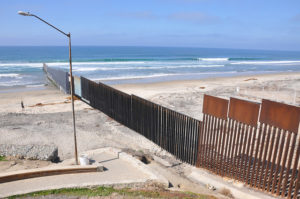 On day five of his Administration, January 25, 2017, President Donald Trump issued his second executive order on immigration, titled, Enhancing Public Safety in the Interior of the United States. It focuses on the removal of persons who illegally enter the U.S. and persons who overstay or otherwise violate the terms of their visas.
On day five of his Administration, January 25, 2017, President Donald Trump issued his second executive order on immigration, titled, Enhancing Public Safety in the Interior of the United States. It focuses on the removal of persons who illegally enter the U.S. and persons who overstay or otherwise violate the terms of their visas.
Here is a description of Trump’s executive order on enhancing public safety within the United States, including the potential effects and impact:
Authority: In the order, Trump cites to the Constitution and federal laws, such as the Immigration & Nationality Act (INA), as grounds for his presidential authority.
The president may set the policy and practices of immigration agencies and officials, in compliance with federal law set by Congress and the U.S. Constitution.
Purpose: The order directs departments and agencies to employ all lawful means to enforce federal immigration laws and ensure the removal of persons who have no right to be in the United States.
Policy Highlights:
1. Faithful Execution of Immigration Laws Against All Removable Persons. The executive order notes, “Many aliens who illegally enter the United States and those who overstay or otherwise violate the terms of their visas present a significant threat to national security and public safety. This is particularly so for aliens who engage in criminal conduct in the United States.”
2. Enforcement Priorities. The executive order instructs the Secretary of Homeland Security to prioritize for removal all persons described in the Immigration & Nationality Act as inadmissible under sections 212(a)(2) (Criminal and related Grounds), 212(a)(3) (Security and related grounds), 212 (a)(6)(C) (Willful misrepresentation to gain immigration benefit) and 235 (Expedited Removal of inadmissible arriving alien), or removable under sections 237(a)(2) (Criminal offenses) and (4)(Security and related grounds).
The order also prioritizes removable persons who:
(a) Have been convicted of any criminal offense;
(b) Have been charged with any criminal offense, where such charge has not been resolved;
(c) Have committed acts that constitute a chargeable criminal offense;
(d) Have engaged in fraud or willful misrepresentation in connection with any official matter or application before a governmental agency;
(e) Have abused any program related to receipt of public benefits;
(f) Are subject to a final order of removal, but who have not complied with their legal obligation to depart the United States; or
(g) In the judgment of an immigration officer, otherwise pose a risk to public safety or national security.
3. Civil Fines and Penalties. The executive order instructs the Secretary to issue guidance and promulgate regulations, where required by law, to assess and collect fines and penalties, as authorized, from persons unlawfully present in the U.S. and from those who facilitate their presence in the U.S.
4. Additional Enforcement and Removal Officers. The executive order instructs the Secretary, through the Director of U.S. Immigration & Customs Enforcement, and to the extent permitted by law and subject to availability of funds, to hire 10,000 additional immigration officers to perform law enforcement functions.
5. Federal-State Agreements. The executive order instructs the Secretary to immediately engage with the Governors of the States, as well as local officials, to enter into INA 287(g) agreements. This allows for State and local law enforcement officials to perform functions of the immigration officers in relation to the investigation, apprehension , or detention of aliens in the United States under the Secretary’s direction and supervision.
6. Terminate the Priority Enforcement Program (PEP) outlined in the November 20, 2014 Memorandum and reinstate the Secure Communities program. The executive order instructs the Secretary to take all appropriate action to end the PEP program, which prioritizes removable persons who have been convicted of an offense listed under the DHS civil immigration enforcement priorities, has intentionally participated in an organized criminal gang to further the illegal activity of the gang, or poses a danger to national security. Trump’s order calls for the revival of the Secure Communities program, which was discontinued by then-Secretary Jeh Johnson in November 2014.
7. Refusal of Federal Grants to “Sanctuary Jurisdictions.” The executive order states that it is the executive branch’s policy to ensure that a State shall comply with 8 U.S.C. 1373 (Communication between government agencies and the Immigration and Naturalization Service).
Trump’s order adds that the Attorney General and the Secretary, in their discretion and to the extent consistent with law, shall ensure jurisdictions that refuse to comply with 8 U.S.C. 1373 are not eligible to receive Federal grants, except as deemed necessary for law enforcement purposes by the Attorney General or the Secretary. It further notes, “The Attorney General shall take appropriate enforcement action against any entity that violates 8 U.S.C. 1373, or which has in effect a statute, policy, or practice that prevents or hinders the enforcement of Federal law.”
The order also instructs the Secretary to publish a weekly list of all the crimes committed by immigrants and the jurisdictions that did not honor detainers with respect to such immigrants.
8. Create an “Office for Victims of Crimes Committed by Removable Aliens.” The executive order calls for the establishment of an office, within the U.S. Immigration & Customs Enforcement, to provide “professional services to victims of crimes committed by removable aliens and the family members of such victims.” The order also instructs the office to “provide quarterly reports studying the effects of the victimization by criminal aliens present in the United States.”
Effects and Impact:
1. Broadening enforcement priorities
The executive order significantly broadens immigration enforcement priorities. It eliminates guidance in the November 20, 2014 memorandum issued by then-Secretary Jeh Johnson under the Obama Administration.
In that memorandum, Johnson noted that Priority 1 for immigration enforcement included aliens engaged in or suspected of terrorism or espionage; aliens apprehended at the border or ports of entry while attempting to unlawfully enter the United States; aliens convicted of an offense for which an element was active participation in a criminal street gang; aliens convicted of a felony as defined by state statute; and aliens convicted of an “aggravated felony” as defined by federal law. Priority 2 included aliens convicted of three or more misdemeanor offenses, aliens convicted of a “significant misdemeanor” (i.e. domestic violence ; sexual abuse or exploitation; burglary; unlawful possession or use of a firearm; drug distribution or trafficking; or driving under the influence); aliens apprehended in the United States after unlawfully entering or re-entering the United States and who cannot prove they have been physically present in the United States continuously since January 1, 2014 ; and aliens who, in the judgment of an ICE Field Office Director, USCIS District Director, or USCIS Service Center Director, have significantly abused the visa or visa waiver programs.
In contrast, Trump’s executive order prioritizes persons who have been convicted of any criminal offense, which may include even minor infractions and misdemeanors. It also prioritizes any removable person who has been charged with (but not actually convicted of) a crime, or abused any program related to receipt of public benefits. It further encourages the removal of any person who an immigration officer deems is a danger to the “public safety or national security,” thus giving wide discretionary power to individual officers.
New guidance has yet to be issued to local immigration officers on how to implement the executive order. Some ICE Field Officers have stopped granting requests for prosecutorial discretion (PD), as described in the November 20, 2014 memorandum, in light of Trump’s order unless further guidance permits this relief. Others continue to grant PD based on prior directive under the Obama Administration, unless new instructions are provided.
With over 500,000 removal cases pending in fiscal year 2017, and immigrants facing years long delays before a judge makes a final decision on their case, the immigration court system is already heavily backlogged. Prioritizing removable persons who do not pose a threat to public safety will make it harder to focus on those who do.
2. Reinstating the 287(g) partnerships and Secure Communities program
The Illegal Immigration Reform and Immigrant Responsibility Act of 1996 added section 287(g) to the Immigration & Nationality Act, permitting the delegation of immigration officer duties to deputized state officers and employees. The 287(g) program was credited by ICE for identifying more than 402,079 potentially removable aliens – mostly at local jails – from January 2006 through September 30, 2015. In a December 20, 2012 news release, however, ICE announced it would phase out the 287(g) program in favor of other, more efficient enforcement programs, such as Secure Communities.
In November 2014, then-Secretary of Homeland Security, Jeh Johnson, issued a memorandum discontinuing the Secure Communities program because it “attracted a great deal of criticism, is widely misunderstood, and is embroiled in litigation…” In its place, Johnson introduced the Priority Enforcement Program to focus on convicted criminals and others who pose a danger to public safety. The memorandum instructed ICE to replace requests for detention (i.e., requests that an agency hold an individual beyond the point at which they would otherwise be released) with requests for notification (i.e. , requests that state or local law enforcement notify ICE of a pending release during the time that person is otherwise in custody under state or local authority).
Trump’s executive order promises to reinstate 287(g) partnerships and the Secure Communities program, which were criticized for fueling community mistrust in the police, being prone to racial profiling, increasing the use of immigration detainers to the detriment of the criminal justice system, and creating confusion over the roles of local, state, and federal agents.
3. Penalizing “sanctuary” cities, counties or states
The executive order threatens to withhold federal grants to jurisdictions (cities, counties, and states) that do not comply with 8 U.S.C. 1373. The order does not specifically define “sanctuary jurisdiction,” but the term generally refers to those that decline federal requests to hold arrestees in jail due to their immigration status or to collect immigration status from suspects.
Since Trump’s election, “sanctuary” cities like New York, Minneapolis-St. Paul, San Francisco and Seattle have vowed to limit their cooperation with federal immigration authorities. They won’t stop immigration authorities from enforcing federal law within their boundaries. But they will focus on local law enforcement so residents don’t avoid talking to the police out of fear of deportation risks or immigration consequences.
Whether federal funds may be withheld for the purpose of forcing “sanctuary jurisdictions” to support immigration enforcement is subject to legal challenges. Detaining individuals after a scheduled release date, to assist with federal immigration enforcement, may violate immigration and Constitutional law.
Furthermore, 8 U.S.C. 1373 merely requires communication between government agencies and the immigration agencies. It addresses the exchange of information regarding citizenship and immigration status among federal, state, and local government entities and officials.
Subsection (a) states federal, state and local government entities and officials may not “prohibit, or in any way restrict” government officials or entities from sending to, or receiving from, federal immigration officers information concerning an individual’s citizenship or immigration status.
Subsection (b) provides that no person or agency may “prohibit, or in any way restrict,” a federal, state, or local government entity from (1) sending to, or requesting or receiving from, federal immigration officers information regarding an individual’s immigration status, (2) maintaining such information, or (3) exchanging such information with any other federal, state, or local government entity.
Section 1373 prohibits government entities and officials from prohibiting or restricting intergovernmental exchange of such information. But it does not impose an affirmative duty on states and localities to collect information from individuals regarding their immigration status, nor does it require states and localities to take specific actions upon obtaining such information.
Conclusion
Expanding immigration enforcement priorities, reviving the 287(g) and Secure Communities programs, and threatening to penalize “sanctuary jurisdictions” are in line with Trump’s campaign positions. Nevertheless, they are costly and likely ineffective strategies for protecting the American public from dangerous “aliens who engage in criminal conduct.”
For information on Trump’s other executive orders on immigration, read:
This article provides general information only. It is based on law, regulations and policy that are subject to change. Do not consider it as legal advice for any individual case or situation. Each legal case is different and case examples do not constitute a prediction or guarantee of success or failure in any other case. The sharing or receipt of this information does not create an attorney-client relationship.
Photo by: Neon Tommy

 On day five of his Administration, January 25, 2017, President Donald Trump issued his first executive order on immigration, titled,
On day five of his Administration, January 25, 2017, President Donald Trump issued his first executive order on immigration, titled,  Donald Trump’s Administration will begin when Barack Obama’s ends on January 20, 2017. The risk of deportation is expected to get higher for unauthorized immigrants, particularly those with illegal entries and certain criminal histories. A Trump Administration could also repeal Obama’s Deferred Action for Childhood Arrivals Program (DACA) and set the stage for H-1B (professional worker) visa reform.
Donald Trump’s Administration will begin when Barack Obama’s ends on January 20, 2017. The risk of deportation is expected to get higher for unauthorized immigrants, particularly those with illegal entries and certain criminal histories. A Trump Administration could also repeal Obama’s Deferred Action for Childhood Arrivals Program (DACA) and set the stage for H-1B (professional worker) visa reform.
 You may face expedited removal from the U.S. if the Customs & Border Protection (CBP) finds you inadmissible and denies your entry, usually at an airport, seaport, or land border checkpoint. The Form I-860, Notice and Order of Expedited Removal, requires you leave the U.S. immediately and brings serious consequences, such as a visa cancellation with prejudice and minimum 5-year bar to reentry.
You may face expedited removal from the U.S. if the Customs & Border Protection (CBP) finds you inadmissible and denies your entry, usually at an airport, seaport, or land border checkpoint. The Form I-860, Notice and Order of Expedited Removal, requires you leave the U.S. immediately and brings serious consequences, such as a visa cancellation with prejudice and minimum 5-year bar to reentry.